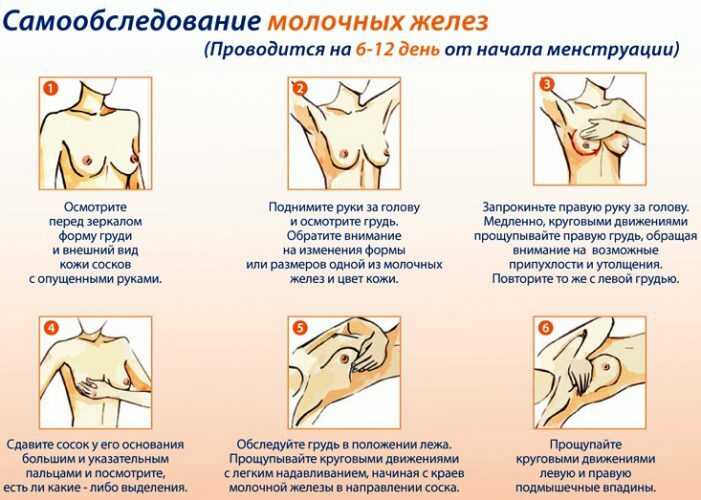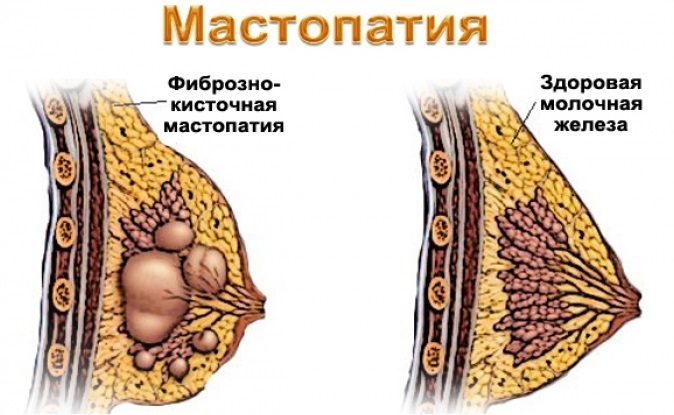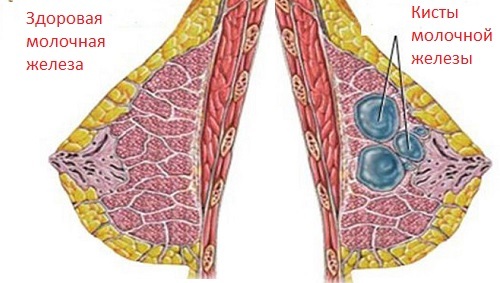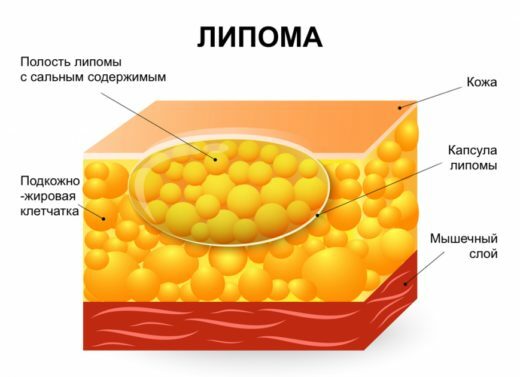The number of newly diagnosed cases of malignant breast formations is increasing annually. In many respects this is due to the way of life of modern women and the late realization of their reproductive potential. But today breast tumors, detected in the early stages, undergo a complete cure. Therefore it is extremely important to be able to detect pathology on time and correctly treat it. What if the seal in the chest is determined before the menstrual period, what can it be?
Normalchanges in the breast before the monthly
Breasts react to all the hormonal disorders in the woman's body. Their tissues also vary cyclically depending on the concentration of estrogens and progestogens in the blood.
The degree of expression is different in all women, often described as a premenstrual syndrome.Estrogens are responsible for the appearance of new "islets" - acini, which subsequently must form lobules of the breast. The gestagens suppress this effect and thus regulate the process of the formation of new tissues, and are also responsible for the differentiation of the acini and their preparation for the production of milk. On the breast tissue affects and prolactin, which is released by the pituitary gland of the brain. It potentiates the action of estrogens. Often, his increased education in the woman's body for a long time does not come to light.
Causes of pain and constriction during menstruation and after
Estrogens in the first phase of the cycle stimulate the accumulation of fluid, including in the mammary glands. As a result, they can slightly increase in size, their sensitivity increases due to edema of tissues. You can determine the lobules of the mammary glands, which are not so noticeable in the first phase. They can be confused with neoplasms. Unlike the latter, lobules are more often irregular in shape, mobile, painless, pass or decrease at the beginning of the menstrual cycle.

Accordingly, the more significant the fluctuations, the more manifestations of changes in the chest. Then the woman complains of severe pain in the chest and armpits( if there are additional lobules), the appearance of seals, painfulness even with light touching.
Pathological changes
In order to identify pathology, to inspect the mammary glands is necessary for 4 to 10 days of the menstrual cycle. It is at this time that the edema subsides and you can most clearly palpate any formations.
How to properly inspect the chest
Inspect the mammary glands preferably standing, and then lying down. If any seal is found, inspection in two positions is mandatory.
First you need to go to the mirror and look at the shape, size of the mammary glands. Then, just as well, evaluate them with your hands behind your head.
The next step is to use the right hand to palpate the left gland and vice versa. Carefully, without causing pain and discomfort, it is necessary to examine all parts clockwise or counter-clockwise.
Similarly, it is necessary to palpate the mammary glands in the prone position. Do not forget to examine the area of the axillary lymph nodes, as, in addition to their increase, you can find additional lobules.
The last step is to inspect the area of the nipple and areola, press down to make sure the absence of pathological discharge.

What can I detect
Normally, palpation of the breast tissue should be soft, without any seals and unevenness. Minor graininess and tightness in women of the reproductive period can be determined. In menopause - only soft tissue. If the compaction in the chest hurts before the menstrual period, then all the unpleasant symptoms pass, most likely it is a lobule that swells in the second phase.

Cysts
Cysts can be of various sizes - from a few millimeters to 10 or more centimeters. They are formed in most cases when the ducts of the mammary glands are blocked. This can cause injuries, surgical interventions, etc.
Cysts are a cavity, more often of regular round shape, filled with liquid. At a palpation formation, elastic, mobile and sensitive naoshchup is defined. Sometimes their rapid growth( within a month by a few centimeters) is noted. In these cases, the woman accidentally discovers a fairly large tumor in the chest. This is due to the intensive production of a secret filling the cyst. It can be serous, as well as purulent in case of infection.
Abscesses
For any abscess characterized by a fairly vivid clinical picture: against the backdrop of palpable painful formation there is an increase in body temperature and deterioration of overall health. Skin over it is changed, red and hot by touch. Women also complain about the pulsating nature of pain in this area.
Abscesses can be formed against the background of mastitis in women with GV, then this is one of the stages of the disease. It is also possible suppuration of cysts, necrosis( necrosis), linden, fibroaden. In these cases, it is customary to talk about tumor abscesses.

Fatty tumors
The second name is lipomas, tumors of adipose tissue of benign nature. It can be either single entities or multiple. In the latter case, it is necessary to exclude hereditary diseases, such as fatty lipomatosis.
With lipomas, a woman often determines irregular forms of education, painless( if there is no necrosis), almost identical on any day of the menstrual cycle. In most cases, they are found in the lower outer and inner quadrants of the chest, which is due to constant friction with the tissue( including the "bones") of the bra.
Thrombosis
The mammary glands are well circulated. At some women during a lactemia veins even more increase and are well appreciable under a skin. In the presence of an inflammatory process, thrombi may form in them or for other reasons. Dangerous situations when they overlap the cavity of the vessel. This condition is called thrombosis of the veins of the breast. In this case, the affected vessel is painful when touched, the skin changes over it( reddens, cyanosis may appear).The breast can increase in size. The condition requires competent and special treatment.
Mastopathy
When mastopathy, all manifestations of premenstrual syndrome are intensified: mammary glands on the eve of menstrual periods increase, "pour", become painful. When palpation lobules are also very sensitive. Sometimes it is simply determined by pronounced rigidity.
In addition, individual formations may be defined, dense, mobile, painless when touching - fibroadenomas.
When pressing on the nipple, a clear or slightly cloudy liquid may be released, and if there is intraprotective papilloma - with blood elements.

Neoplasms
If you regularly examine the breasts and carefully monitor their condition, the signs of malignant tumors can be seen in the early stages, when a radical cure is possible.
With breast tumors, the nipples begin to retract, a symptom of the "lemon peel" appears. With palpation, you can find different sizes of formation, whether regular or not, often welded to surrounding tissues( a single conglomerate is defined).Axillary lymph nodes can be enlarged, sometimes there is spotting from the nipples.
Look at the video about breast self-examination:
Symptoms requiring a doctor
If a woman has noticed that she has sebum in front of her breasts, it is necessary to perform self-examination for 5-10 days of the cycle. At preservation of educations it is necessary to address to the expert for specification of character of a pathology. In any case, even additional examinations( ultrasound, mammography) are performed after menstruation, because at other times the results are not so informative because of swelling of the breast tissue.
So, if you find the following symptoms, you need to see a doctor( gynecologist, mammologist, oncologist):
- When you identify any formations, especially single tumors that slowly increase in size.
- If suddenly the nipple of the breast has become entangled or assumed an unusual position.
- If the contour of the breast( including with the arms wound behind the head) is uneven, the tuberosity, compaction, the symptom of the "lemon" crust are determined.
- In the case when there is a liquid when pressing on the nipple, especially with an admixture of blood( normally, clear discharge can be for another two years after breastfeeding, as well as with the established prolactinoma of the pituitary gland).
- If the mammary gland is very painful, its skin is changed, the body temperature is increased.
- With detectable axillary lymph nodes.
 We recommend reading the article about the mammary glands during menstruation. From it you will learn about the causes of pain in the chest before, after and during menstruation, the causes of severe pain, going to the doctor and treatment.
We recommend reading the article about the mammary glands during menstruation. From it you will learn about the causes of pain in the chest before, after and during menstruation, the causes of severe pain, going to the doctor and treatment.
Diagnosis
After consulting a specialist and general examination, palpation, the doctor can only assume the nature of the pathology. For further clarification, an additional examination is always necessary. It includes the following:
- Ultrasound examination of mammary glands for menstruating women up to 45 - 50 years of age and according to indications. It is better to perform it on the 5th - 10th day of the cycle.
- Mammography is performed after 45 - 50 years and according to indications. This study is suitable when the tissues of the mammary glands are in fatty involution. If the percentage of the glandular part is large, the mammogram is not very informative.
- Biopsy, which is most often performed under the supervision of ultrasound. Sometimes it can serve not only as a diagnostic procedure, but also as a therapeutic procedure, for example, in the case of cysts.
- If suspected of papilloma of the ducts, the radiopaque examination is carried out using special solutions.
- Sometimes the diagnosis can be established only after sectoral resection of the breast or removal of the tumor.
Treatment of pathology
Once the nature of the compaction in the chest is clarified, the direction of therapy is determined. Both conservative and surgical methods are used.
In any case, drug treatment mainly helps to cure unpleasant symptoms( pain, roughness, etc.), somewhat reduce pathological foci. But getting rid of the disease is not always possible.
All forms of mastopathy( with the exception of fibroadenomas), as well as thrombosis, have conservative therapy in 95% of cases. Used vitamins, hormones, dietary supplements, herbal medicine, etc.
Tactics with lime depends on the size: small ones are simply observed, and large and discomforting are removed.
Treatment of breast abscess only operative - drainage of the cavity on the background of antibacterial therapy.
The line between norm and pathology in case of pain and seals in the mammary glands is very thin. Regular self-examination can detect changes, including malignant tumors in the early stages. Therefore, you should not neglect the monthly examinations, and if there are suspicious foci, you must contact a specialist for additional examination.


